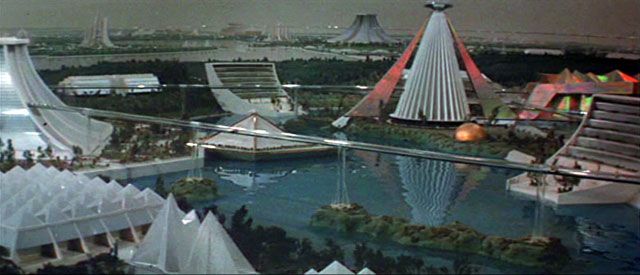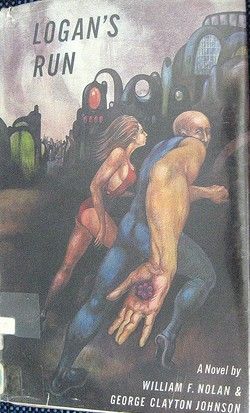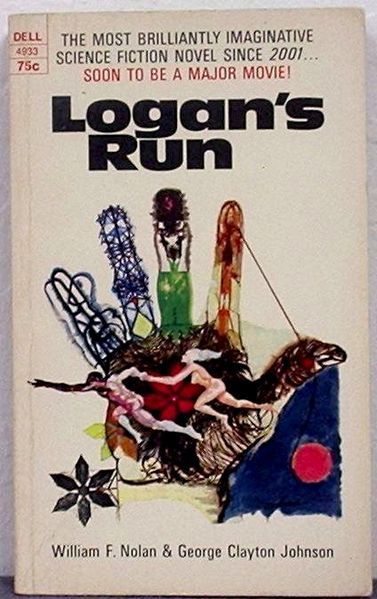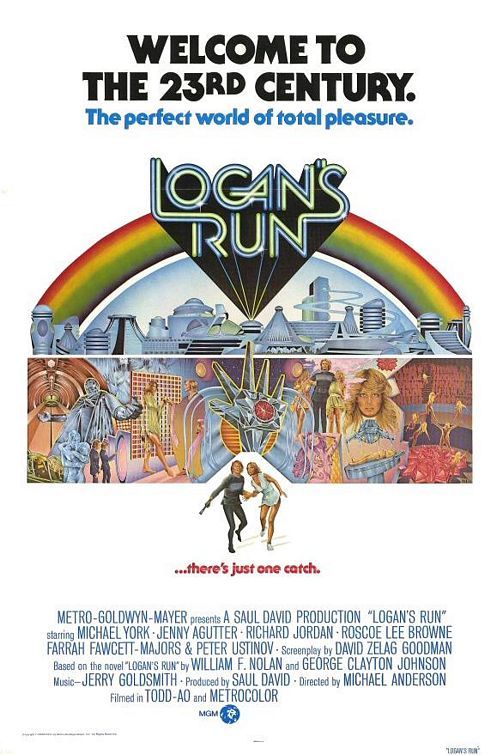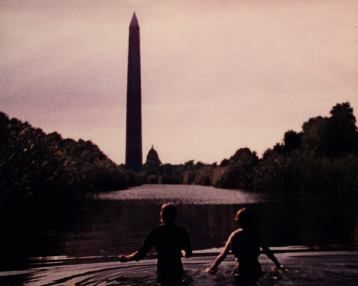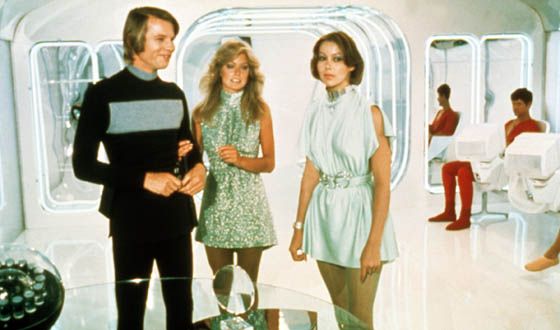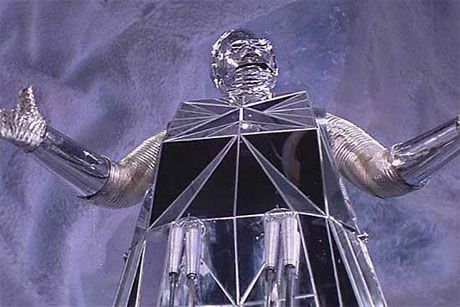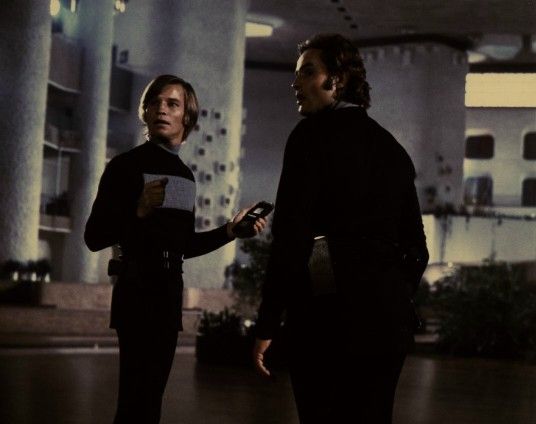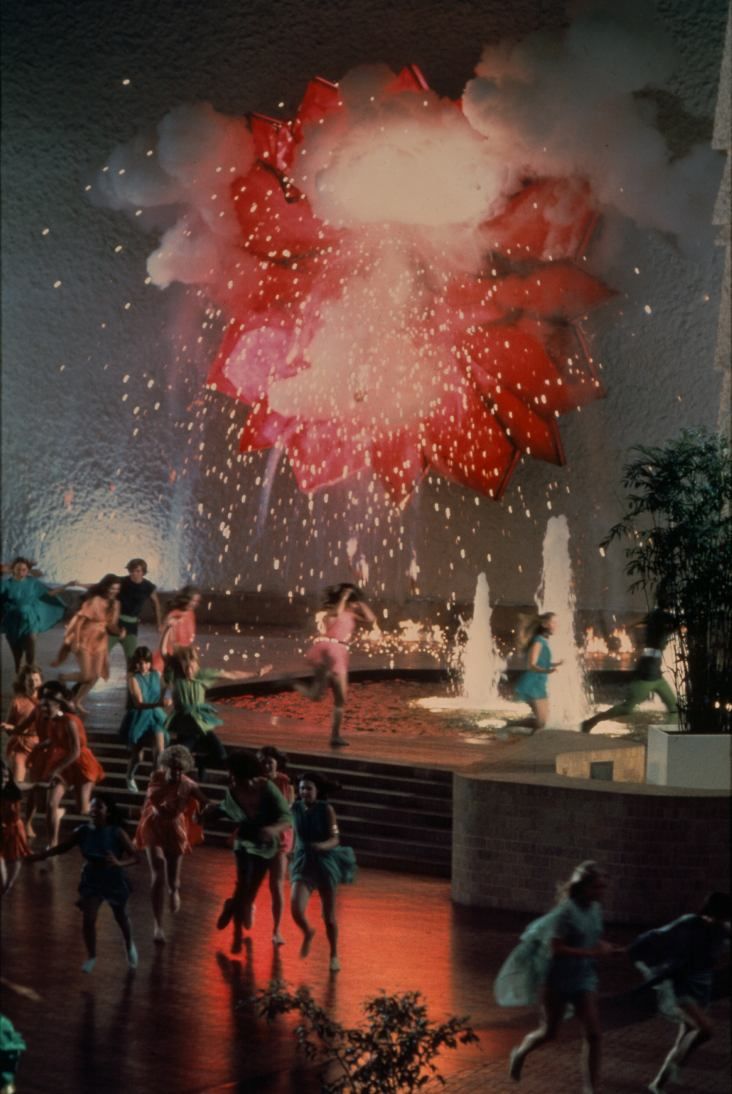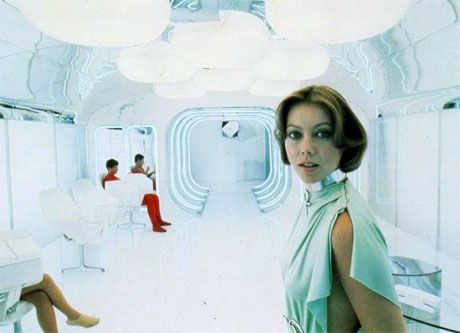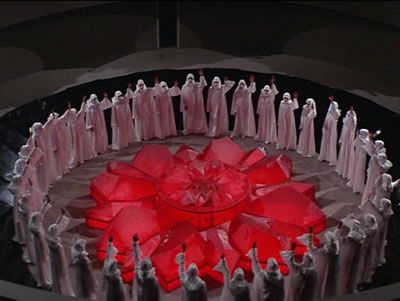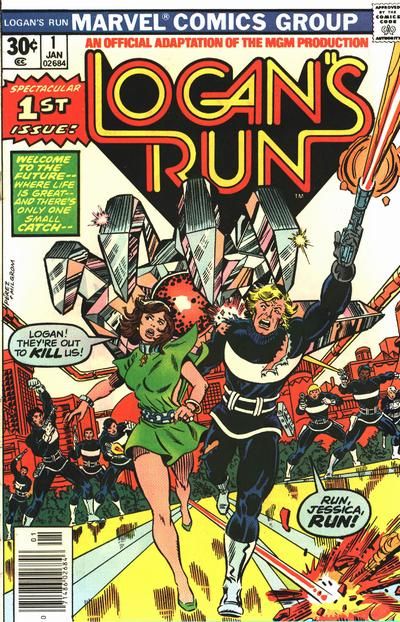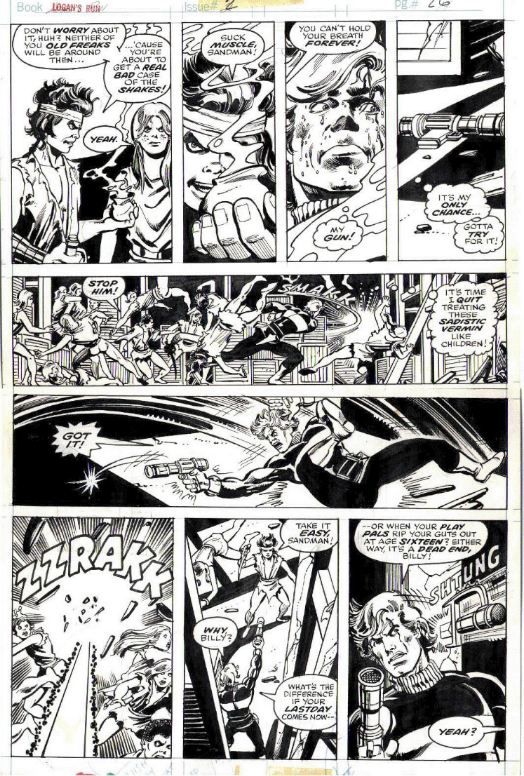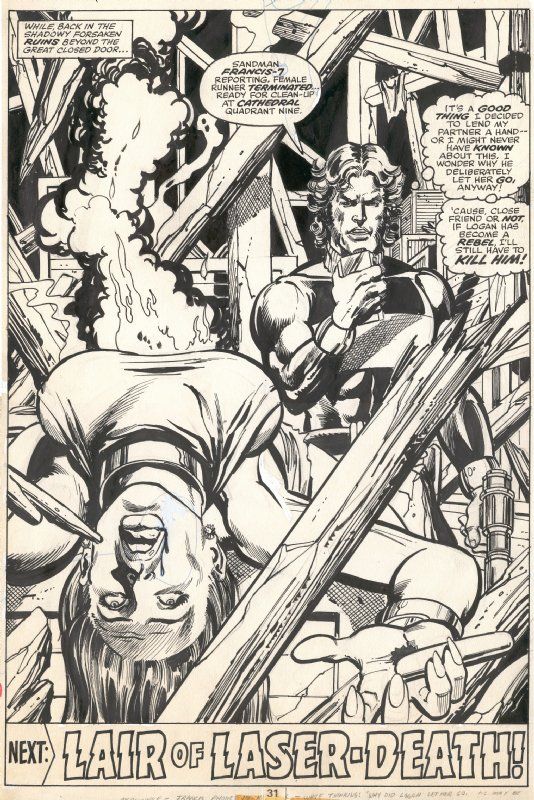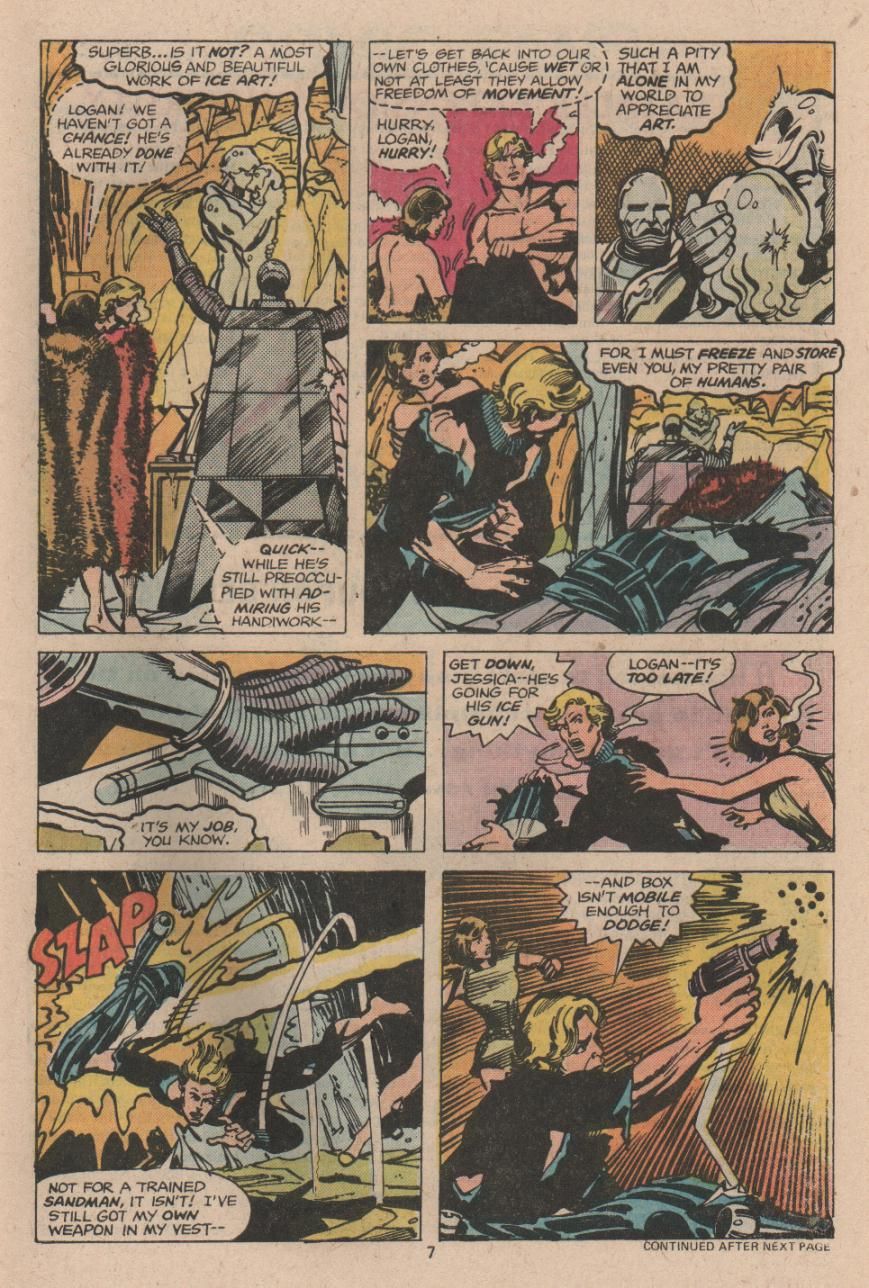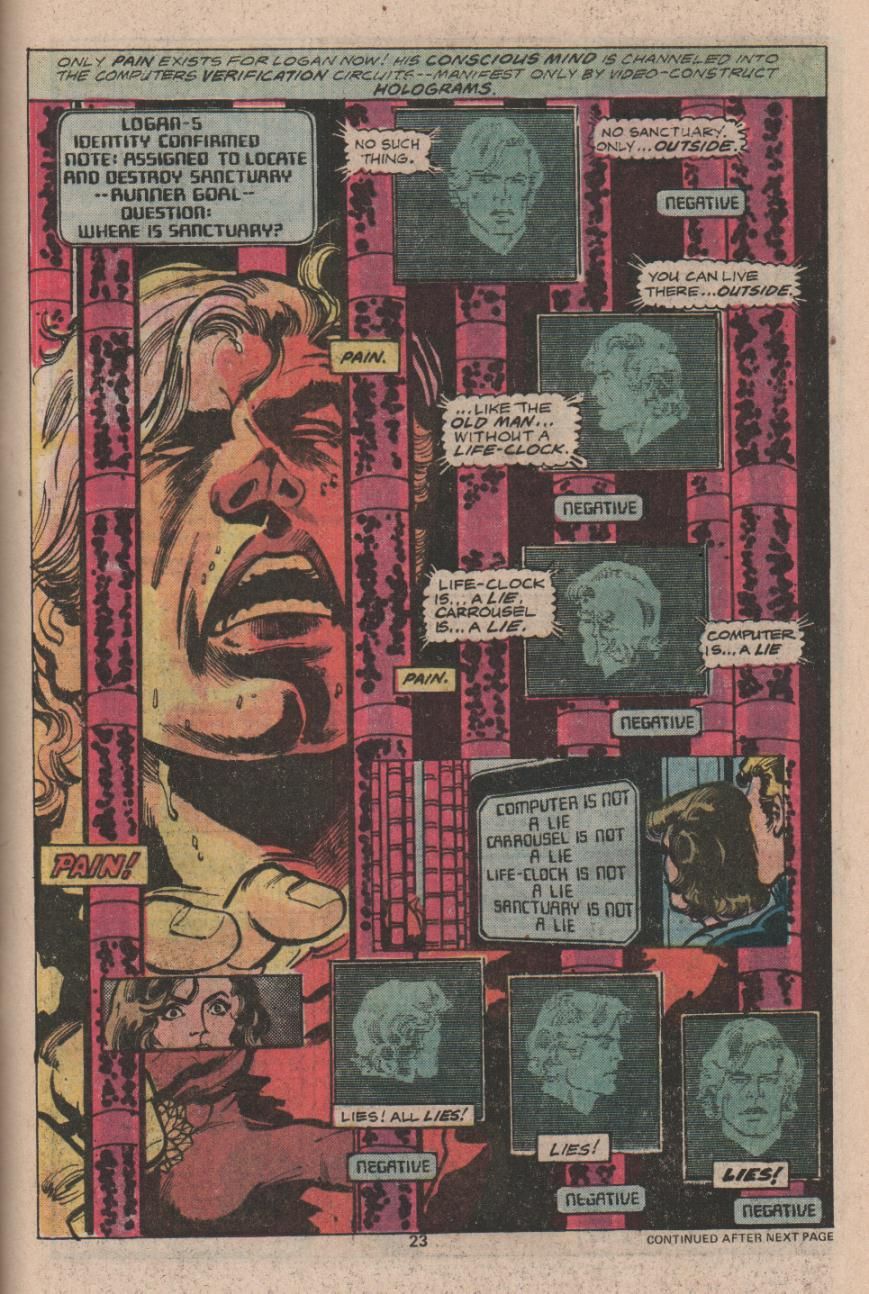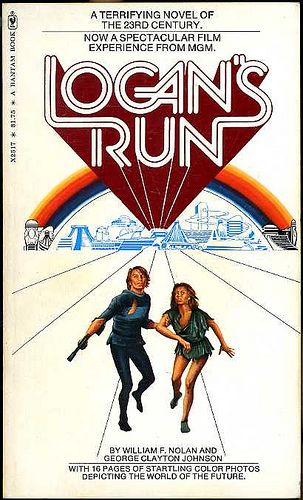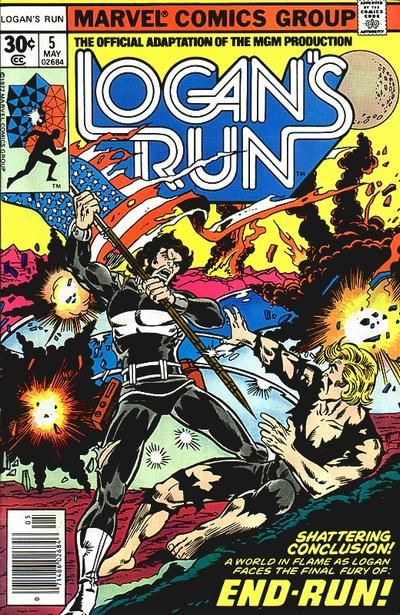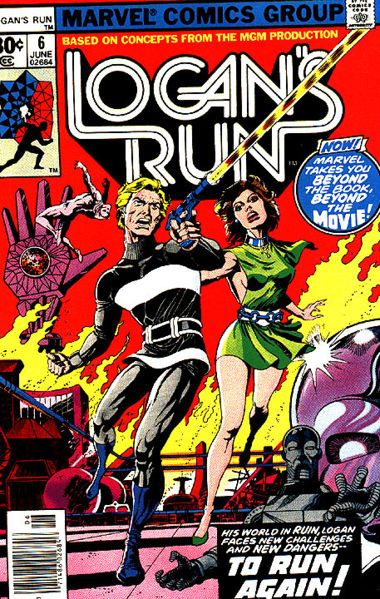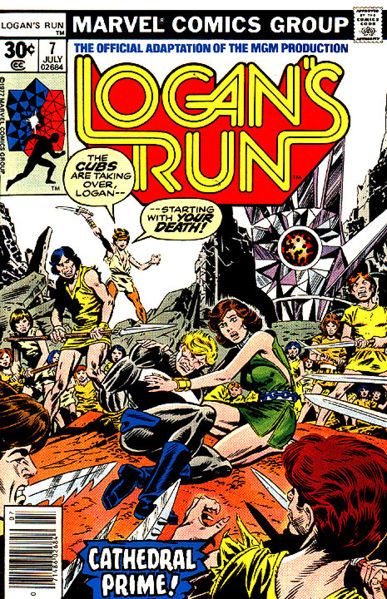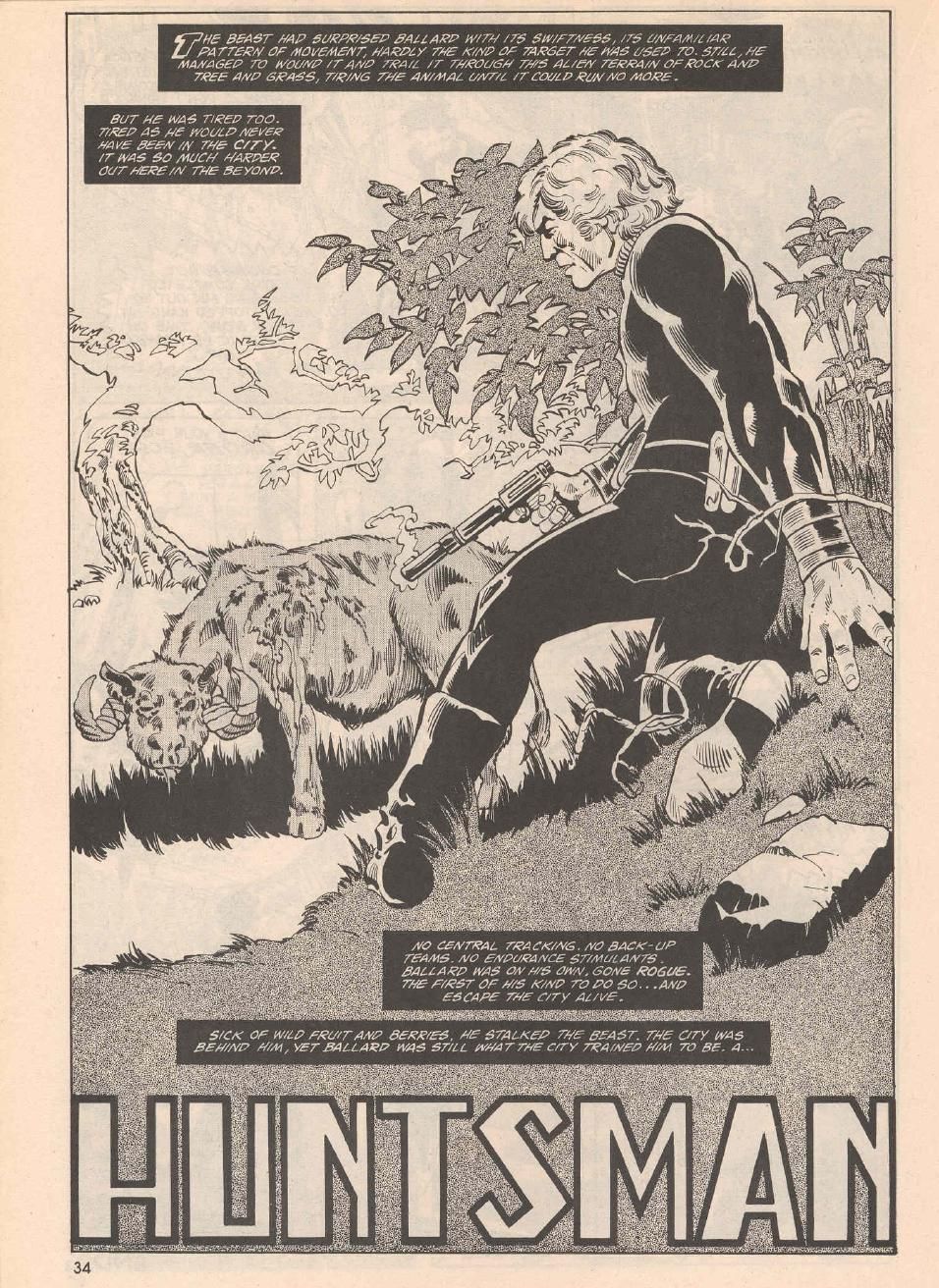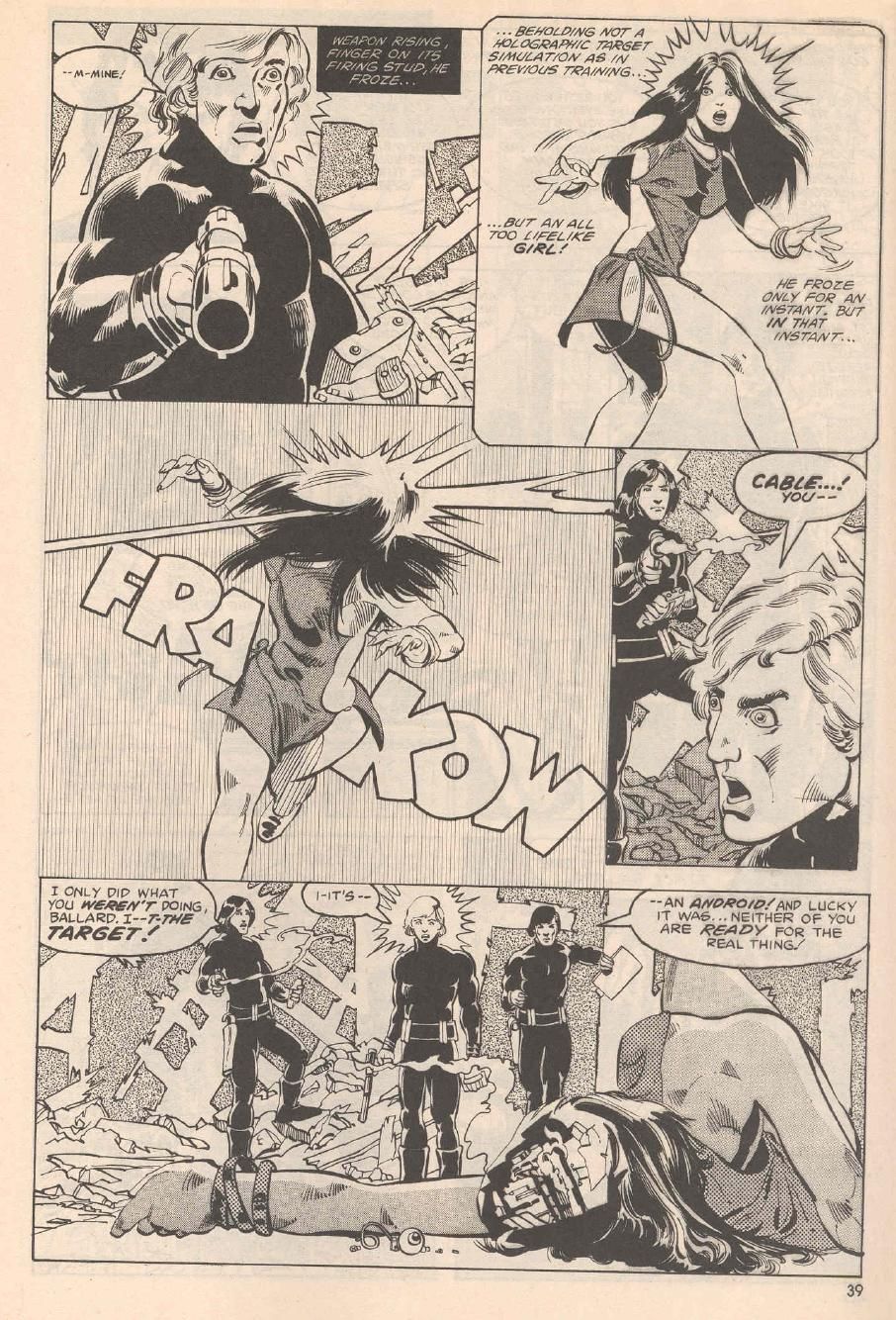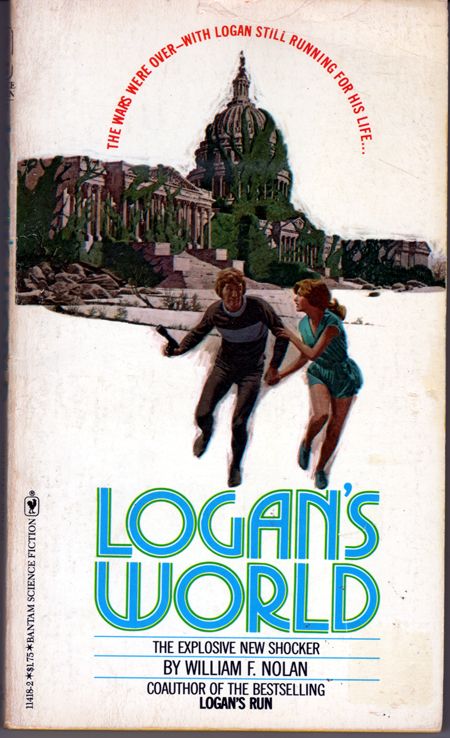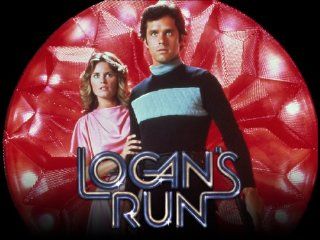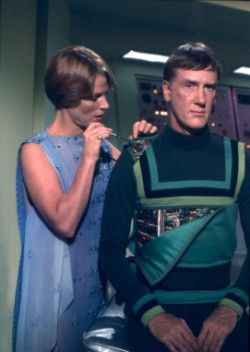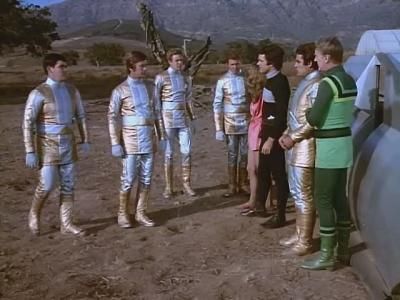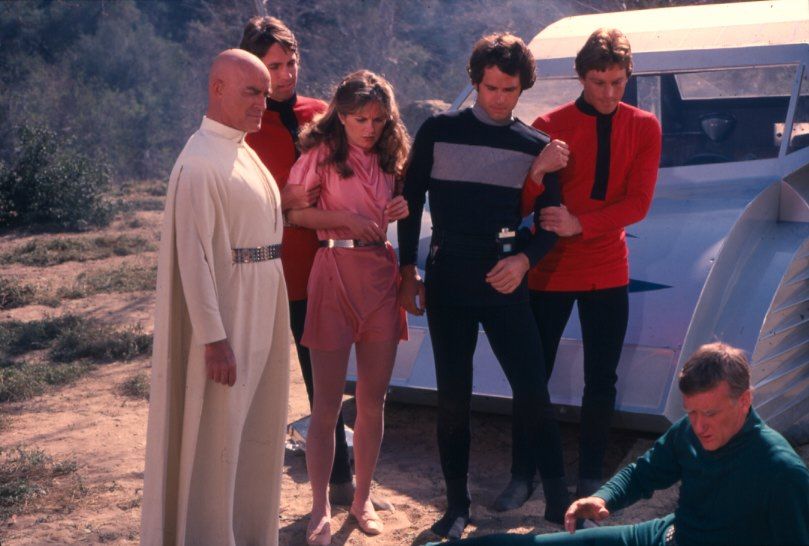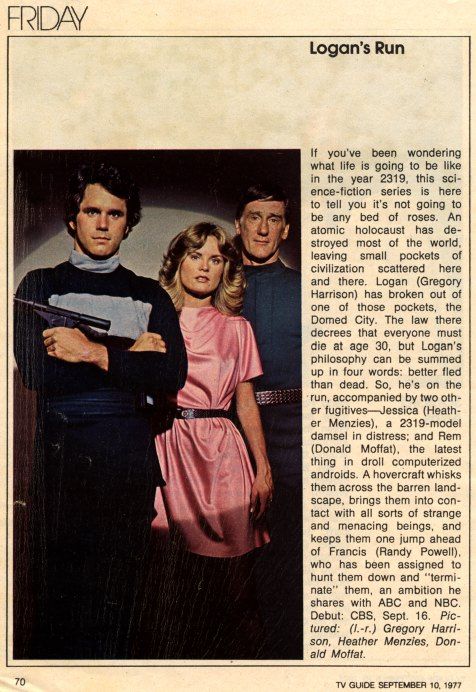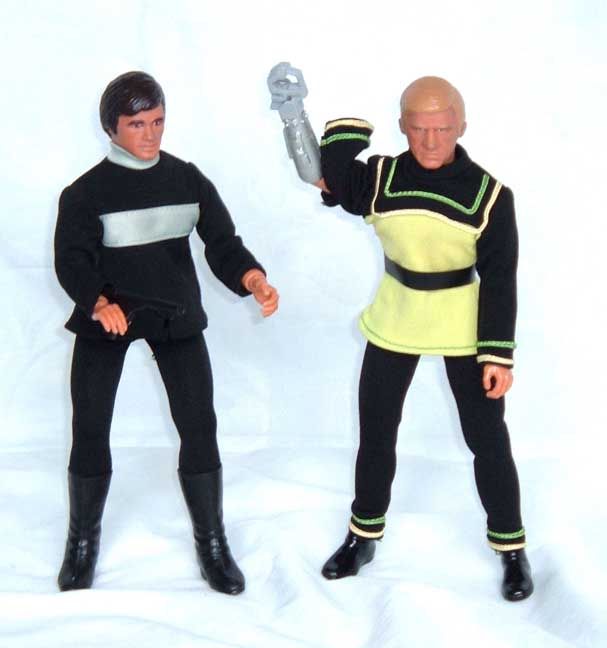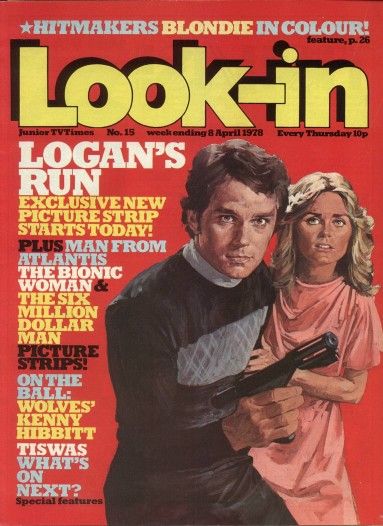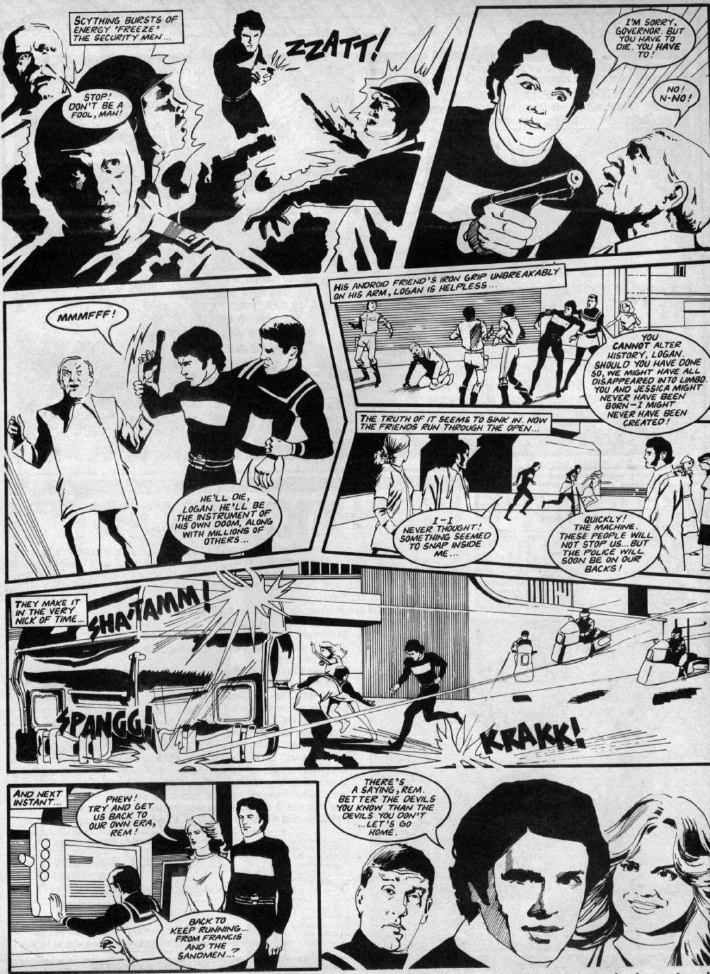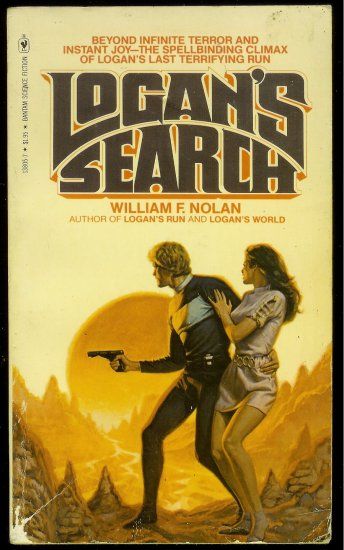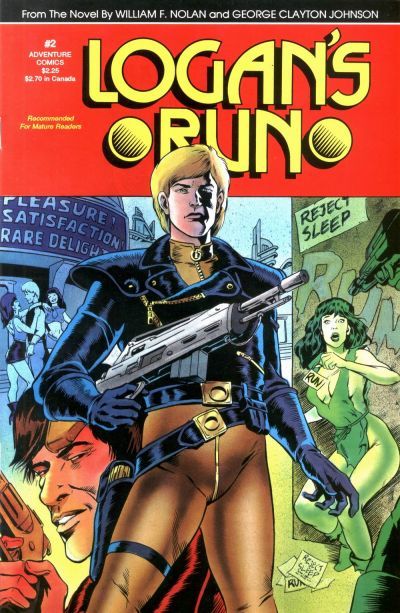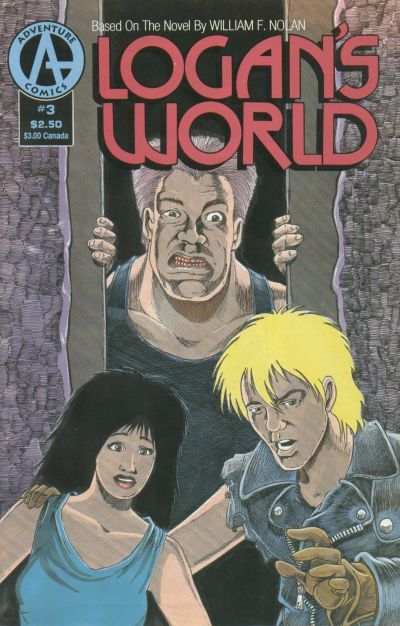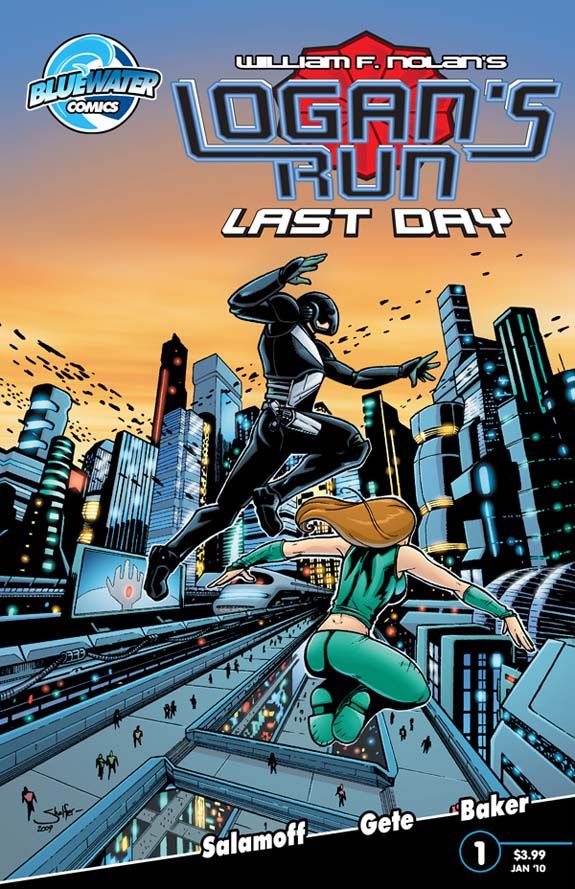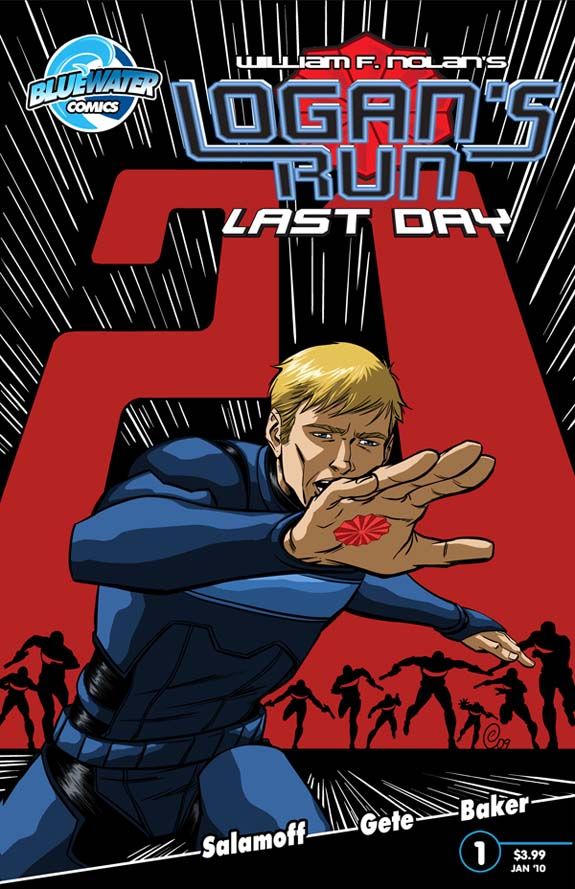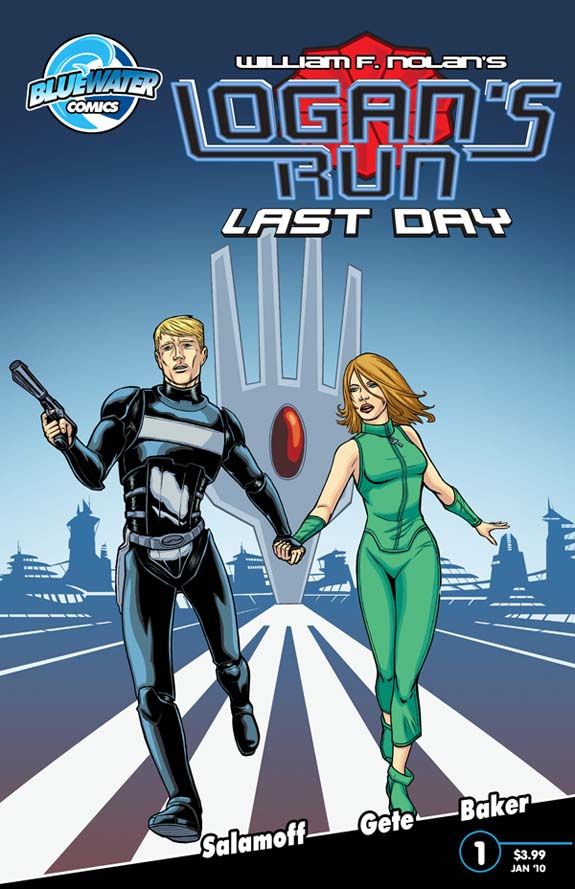It was a 1967 novel that spawned two sequels, a big-budget Hollywood movie from a major studio, a television series, a line of toys, and four separate comics adaptations from four different publishers.
And yet, when you say "Logan" to a comics fan today, the assumption is that you must be talking about Wolverine. Fame is so fleeting.
*
According to his creator, SF novelist William F. Nolan, Logan the Sandman began when Nolan was asked to lecture a college class in 1963. I'm guessing this was probably one of the first times anyone had seriously addressed the subject of science fiction in an academic setting, even just as a guest speaker. I think Robin Scott Wilson's famous Clarion SF workshops were still five or six years away.
Anyway, at one point in the lecture, Nolan suggested that one way into a science fiction story was to take a common cliche and flip-flop it -- i.e., instead of "Life begins at forty," postulate a society where it is mandated that life ends at forty.
The idea wouldn't go away, though, and Nolan scribbled a note to himself:
Do story of rebel cop in overpopulated world. 200 years from now. Mandatory early death via computer. Future police enforce death rule. Cop reaches death age, refuses to die, runs -- using special knowledge of system to stay ahead of fellow cops who pursue him.
There it lay for a while. A couple of years later, Nolan kicked around the idea with his friend George Clayton Johnson, who thought it would make a great screenplay. Nolan agreed but thought the chances were better of selling it to Hollywood if they did it as a book first. Working in tandem, the two blew out a draft in three weeks that they were both pleased enough with to try bypassing the normal science fiction outlets and see if they couldn't get it picked up by a major hardcover house.
The book impressed an editor at Dial Press (interestingly, it was a young fellow named E.L. Doctorow who would eventually go on to greater things) and Logan's Run appeared in September of 1967.
It begins with Logan on his "Lastday," feeling futile and useless and wanting to make some sort of lasting contribution to society. Logan is a DS ("Deep Sleep") operative, a "sandman" that enforces the mandatory death at twenty-one of all citizens. He tracks down "runners," people that try to flee rather than submit themselves to one of the many Sleep parlors scattered throughout the country. Very well, in order to make his mark and leave some sort of legacy, Logan decides he will pose as a runner and spend his last twenty-four hours tracking down the mysterious rebel underground that leads runners to a place called Sanctuary.
With that, the chase is on. Circumstances throw Logan together with a girl named Jessica who really is running, and he wins her trust after saving her life. Over the course of the twenty-four hour chase that follows, Logan finds himself both falling for Jessica and realizing that she is right -- that he's spent his entire life enforcing death sentences no one should ever have imposed. Following the rebel underground network Logan and Jessica travel all over the country via mazecars, a sort of super-subway system maintained by the Thinker, a supercomputer that runs the world. There are several spots where the Thinker's network has fallen into disrepair and the runner underground has taken control -- an underwater plankton processing facility on the Pacific Coast, the Cathedral District in L.A., a ruined Washington D.C., a prison facility in the Arctic -- and Logan and Jessica are rocketed from one action set-piece to the next with barely a pause for breath as they thread the maze to Sanctuary, with Logan constantly having to either persuade the rebels he's for real or fight his way through them, all as Logan's former partner Francis is relentlessly tracking them down.
I'm really not doing it justice. The novel is a tour de force and it holds up very well today. Lowering the compulsory death age from forty to twenty-one allows Nolan and Johnson to construct a remarkable and compelling future society that was extrapolated from the youth-worship and microscopic attention span that was even then beginning to infect American culture. There are lots of wonderful throwaway bits -- the glasshouses where desperate lonely people can hook up for a night of anonymous sex, the crystalline color-coded "life-clocks" implanted into the palm of the left hand of everyone at birth, the feral children living in the ruins of Cathedral, the mad cyborg Box that rules over the Arctic prison Hell. All done with the poetic flair and command of language that was just beginning to supplant the textbooky, expositional nuts-and-bolts engineering style that had dominated science fiction prose since the forties. It's a remarkable literary tightrope walk -- an exhortation to youth to respect history, but done in the very "new wave" style that the youthful SF fans of the day were embracing.
At the same time, Nolan and Johnson never forgot that at its core the story is an action premise -- Logan is a cop turned criminal, and the book is a chase story that never lets up. Logan himself is designed amazingly well as an action hero -- DS operatives are badder than Navy SEALS, trained in martial arts and packing a special gun with ammo that can be switched from Tangler to Ripper to Nitro to Vapor to Needler to Homer. The fight scenes are among the most gripping and visceral I've read in any action novel in any genre. Even the chapter headings are done as a countdown -- starting with ten, then nine, eight, seven and so on down to zero.
Logan's Run did generate some Hollywood interest, though the hardcover didn't do all that well. Despite some great reviews, the book only appeared as a first printing of 5000 and there was no second edition from Dial.
The paperback edition proved to have legs, though, and eventually the book got picked up by MGM. A lot of different directors tried to crack the project -- George Pal, Irwin Allen -- but nobody really had a handle on how to preserve the spectacular action of the novel. Nolan and Johnson had done a screenplay but as is usual in Hollywood, no one really wanted to talk to the authors of the book about how it should be done. The project languished in development hell at MGM from 1968 to 1975.
Finally producer Saul David hit on the notion of compressing the action into one domed city. The undersea plankton processing plant could be under the city, and Box's icy prison would be just above it, and old Washington could be just a day's walk away from the dome. So a lot of expensive locations would be eliminated and the movie wouldn't have to do all the setup and exposition of how the mazecars traveled from city to city and so on.
That was the plan that eventually was greenlit in 1975, and the movie went into production with a screenplay by David Zelag Goodman.
Logan's Run premiered to mixed reviews in June of 1976 and went on to become a modest hit.
Despite that, Nolan and Johnson hated Goodman's screenplay, and I have to admit they had reason to. The movie ends up being a classic example of the basic misunderstanding Hollywood usually brings to any book adaptation, but most especially to science fiction.
The major flaw in the movie is that they kept many of the action set pieces from the novel, but threw away the interior logic that held them together. No longer are Logan and Jessica following a rebel "underground railroad" from one stop to the next; the movie starts with that idea but inexplicably discards it about half an hour into the story, in favor of a more general (and far more cliche'd) escape into the 'outside world.'
Likewise, the movie retains the novel's scenes with the "New You Parlor," the glasshouse, the killer cyborg Box and even the underwater plankton station, but they're reshuffled from the book, ending up as weirdly compressed and pointless.
Director Michael Anderson ignored any opportunity for youth-culture critique inherent in the premise and instead insisted that the movie was "the classic story of Utopia, but with a catch." Which led to probably the single biggest dumb change Goodman made in his screenplay, the re-imagining of Logan's society as consisting entirely of shallow, silly hedonists, living in "a perfect world of total pleasure." Those are about the least likely people imaginable to embrace the ideal of voluntary death at age 21 -- or even at thirty, as the movie depicted -- in order to achieve a greater good. Moreover, such people are even more unlikely to create and equip an organization like the super-efficient, highly-trained Sandmen to enforce that ideal.
That's actually my biggest complaint with the film -- Michael York is simply not convincing as Logan, the Sandman that's tough enough and skilled enough to outrun and outfight all his former colleagues, especially the fanatical Francis. The relentless suspense that drove the novel is abandoned in favor of cliche after cliche -- the goodness of nature versus the evils of technology, characters picking their way through twentieth-century ruins marveling at our odd customs, etc., etc. The final sequence, with Logan managing to disrupt and destroy the supercomputer that runs the domed city just by.... you know what? To this day, I'm not sure how the hell he does it. Logan's been captured by DS, tied to a chair in a room full of consoles and just because Logan apparently, um... disagrees with the computer voice? Talks smack to it? -- the whole city starts blowing up. The scene is so blatantly illogical that it mostly just leaves you baffled.
In fairness, it's not all awful. As wrong as Michael York was for the hard-as-nails Logan, the casting of Jenny Agutter was exactly right. She's damn near note-perfect as the emotional and idealistic Jessica.
And the movie looks incredible. It's a visual feast, and absolutely deserved its Oscar win for special effects. The Carousel "renewal" scene doesn't make that much sense but I have to admit that even by today's post-Star Wars, CGI standards, it really looks kewl.
Anyway, despite being kind of a muddled mess, the film was a hit and MGM thought highly enough of it to license it out. The book got a new paperback printing from Bantam, and Marvel did a tie-in comic series as well.
That was my first encounter with Logan and his world. I've mentioned before that in the 1970s, I rarely got to see movies in the theatre, but I was all over the novelizations or comics adaptations of anything that looked cool. (This was also how I first discovered Star Trek, Fantastic Voyage, Planet of the Apes, Kung Fu with David Carradine, and countless other geek entertainments of the 60s and 70s.) My mother was rather strict about TV and movies but for whatever reason books and comics got a pass.
Anyway, I saw the Marvel comic on the stands and, knowing I'd probably never get to see the movie till it ran on network television, grabbed it.
And it really was a good comic. Writers Gerry Conway and David A. Kraft did a lot to try and cover the basic illogic of the movie screenplay, making several changes that streamlined and sharpened the action. And George Perez didn't bother trying to capture the likeness of Michael York or any of the other actors, except in the most general way. This was all to the good -- in the comics adaptation, York's vaguely prissy portrayal of Logan was nowhere to be seen. Instead George Perez gives us a muscled, believable action hero. Moreover, teaming Perez with inker Klaus Janson was genius on someone's part.
It ended up as a match made in comics heaven. Perez and Janson really knocked it out of the park, they brought such power and conviction to the job that I was instantly sold on the whole thing. It was that, coupled with Conway and Kraft's smart scripts, that made me a fan.
Those were the days when movie adaptations were done in multiple parts -- Logan's Run was launched as an ongoing monthly, with the first few issues adapting the movie and then original stories would follow.
(This same strategy would later be repeated by Marvel with both Star Wars and Star Trek: The Motion Picture, but Logan came first.) It was definitely the right way to do it -- this was a script that needed more space and exposition to be told properly, not less, and the serial comics form suited it a lot better.
In fact, I got so excited I ran out and bought the Bantam paperback after reading #2, because I just couldn't wait for the next issue.
That was where I encountered the original novel and fell in completely in love with the story. I was still enjoying the comic, but even the Marvel version's fixes weren't enough to eclipse the awesome of the actual book as compared to the movie script's interpretation.
What really whetted my appetite, though, was when the adaptation concluded in #5 and Marvel began doing original stories.
Sadly, Perez left the project, replaced by Tom Sutton. Sutton did a nice enough job, though the quality dipped some; it's a bit unfair, I suppose, to hope that Tom Sutton and Terry Austin would be able to match what Perez and Janson had been doing.
On the other hand, the first post-adaptation original script from John Warner was everything I could have hoped for. He picked right up where the movie left off, with Logan having to cope with the angry citizenry of the city he'd just destroyed, people not the least bit grateful for being freed from the oppressive yoke of... well, having everything provided for them.
Best of all, Warner cleverly incorporated bits from the novel into his story, most notably the original six-chambered Sandman Gun with its varying functions. Klaus Janson was even back on the inks by #7 and I settled in for what I figured was going to be a great ride.
Unfortunately, the ride stopped before it started. #7 was the final issue of Logan's Run from Marvel... canceled in mid-story, its cliffhanger forever unresolved. (For years I was sure that I'd somehow missed #8... I couldn't believe Marvel would leave me hanging like that, they were usually so obsessed with tying up loose ends.) I even got excited a few years ago when I heard that a somewhat re-edited inventory story appeared in Bizarre Adventures #28, and immediately tracked down a copy, thinking AT LAST! ...but it had nothing to do with what Warner had done.
Called "Huntsman," it was a little flashback vignette about Logan and Francis in Sandman training. (The names were changed, of course, since technically Marvel no longer had the right to publish Logan's Run comics, but you could easily tell who was who.) It was a nice enough story from Archie Goodwin and Michael Golden, but those of us who were hoping for some closure for the Warner story cliffhanger were disappointed. (Okay, it was probably just me, and yeah, I'm still bitter about it.)
Meanwhile, William F. Nolan was still invested in his creation. He was pitching Saul David and MGM on a sequel to Logan's Run called Logan's World, very much in the same spirit of what John Warner had been trying for Marvel; the plot was about Logan and Jessica trying to build a life for themselves in the ruins after the Thinker had been destroyed, and eventually pitted Logan against a group of other Sandmen determined to rebuild the supercomputer and reinstate the old system.
MGM didn't bite, so Nolan did it as a novel instead. It's not as focused as the first book but it's still a great read.
Instead of the Logan's World sequel film, MGM and Saul David sold the property to CBS as a weekly television series. It starred Gregory Harrison as Logan and Heather Menzies as Jessica.
Nolan initially did a draft of the pilot for this, and gave Logan and Jessica an android companion, Rem (played by Donald Moffat.) The idea was that they would wander around the Earth and have adventures in the ruins of the post-computerized paradise Logan had destroyed in the movie.
But suddenly Saul David was off the project and instead it went to Ivan Goff and Ben Roberts -- the Charlie's Angels guys. They had their own ideas on how to make a weekly series work, and Nolan walked off the show. Goff and Roberts did a rewrite, then Len Katzman did another rewrite to pad it out to a 90-minute movie, and the result was mostly a mess.
Basically Goff and Roberts' changes were designed to dumb everything down and incorporate familiar elements from other TV shows. Instead of picking up where the movie left off, the TV show opened with a much sillier retelling of the movie story (incorporating as much of the MGM footage as was feasible) and then setting it up as an ongoing chase, with Logan and Jessica escaping from the domed city and venturing across the country, having a new adventure in a new post-holocaust community every week. The concept became sort of a landlocked Star Trek -- each week, Logan, Jessica, and Rem would drive their hovercraft to a different little city-state of the ruined Earth, meet a new group of residents with some freaky cultural hangup, and solve their problem, whatever it might be. (Freeing the slaves, discrediting the cult leader, defeating the androids, whatever.) At the same time, the producers added the element of the determined Sandman Francis chasing the three of them in his own hovercraft, sworn to return them to the City of Domes for execution. (Like Lieutenant Gerard chasing The Fugitive, or Jack McGee chasing The Incredible Hulk.)
There were some pretty good episodes, and the actors did their best -- Donald Moffat, especially, was a charmingly whimsical Rem. Showrunner Len Katzman at least recruited real SF writers to work on the series (D.C. Fontana, David Gerrold, and Harlan Ellison all did scripts for the show) but in the end it still came across as generic. There was no real attention paid to the fact that the premise simply didn't make sense.... if all Logan and Jessica wanted to do was live their lives in peace, they could have settled in any one of the villages they saved from evil raiders or religious fanatics or whatever the menace of the week had been. Likewise there was never any explanation given for why Francis was so fiercely determined to bring them back for trial, especially once he too was out of the domed city and could see for himself how everyone had been lied to.
Even as a kid I could smell the deja vu that hung over the whole enterprise. I hung in there with it, but even I couldn't get very invested... especially since I'd already seen Genesis II and Planet Earth and even Ark II. By the time Logan's Run was on CBS in the fall of 1977, it was old hat. It lasted 13 episodes and the last few only aired in Britain. (If you are curious, it is available from Amazon as a video download, here.)
That didn't stop the studio from merchandising the hell out of it, though. There were plans for a toy line, though I don't think they got past the prototype stage.
Those prototypes command huge sums from collectors today, I gather.
And over in Britain, they took another swing at a Logan's Run comic, this time one based on the TV show.
It ran as a two-page serial strip in Look-In magazine, and though I'm afraid I haven't been able to track down who worked on it, the samples I've seen aren't bad. The art looked a bit amateurish and it's rather painfully obvious where the artist was lightboxing publicity stills, but story-wise it was passable.
Certainly it was as good as the TV series itself was -- admittedly a low bar, but still, it was an okay strip. It ran a few months and that was that.
William Nolan went back to the well one last time in 1979, for Logan's Search, published as a paperback original from Bantam.
It's an okay book but this time there was a faint feeling of deja vu here as well. This time aliens transport Logan into a parallel world where the cities and Sandmen were not destroyed, and force him to re-enact his initial run again... apparently, just as a social experiment, or maybe because it's what they do instead of watching TV. I can't remember offhand, but I do remember the feeling of disappointment I had after reading it. That was the last we saw of Logan for a while.
However, I wasn't the only comics fan out there who remembered Logan, especially the Logan of the books, with fondness. In 1990 Malibu and Barry Blair published a very faithful adaptation of the original novel as a six-part miniseries.
William Nolan even wrote a foreword for it. They followed it up with another six-parter adapting Logan's World.
However, despite Blair and company's heart clearly being in the right place, the art is so excruciatingly awful it hurts to look at the thing. It didn't really make much of a splash despite Nolan's enthusiastic support, and the effort got swallowed in the early 90s black-and-white glut.
Now, BlueWater Productions is poised to try again.
Once again, it's being spearheaded by a fan of the novel. Paul Salamoff actually is collaborating with William Nolan in order to update a couple of plot points from the original story, and plans are at this point to adapt the whole trilogy.
There's also talk of another big-budget movie, this time involving Nolan directly, and produced by Joel Silver.
The comic premieres in January 2010 and I wish them well. Certainly, I plan to check it out. I'm still rooting for a successful Logan's Run comic... because even though the X-Men's Logan is the more famous one, I've always thought this one is more interesting. If only someone would actually do it right. Yeah, I'm looking at you, BlueWater guys. Let's hope the fourth time's the charm.
See you next week.

